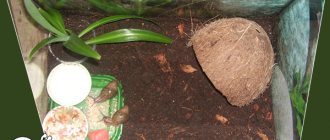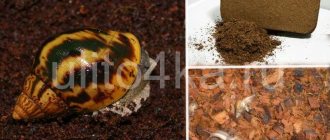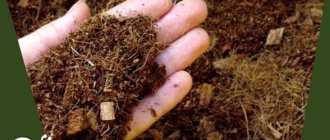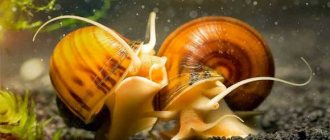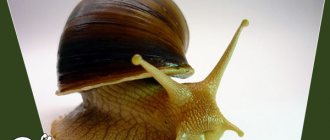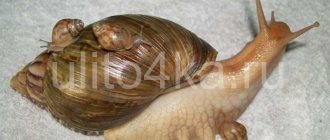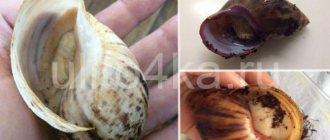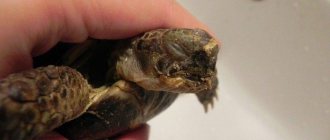Hello, my dear. I want to thank everyone for leaving comments and asking questions. A few days ago I received a letter from one of my readers in my inbox.
In it, she talks with great love about her snail, who is more than 8 years old. About the many problems and illnesses that they had to face during this time. It would seem like a snail, what’s wrong with it, but how the heart becomes attached to it. At the end of the letter, the woman said that recently her snail had become very weak and was not feeling well. Therefore, he often thinks about the time when he will have to say goodbye forever. What to do in such a situation, what is the right thing to do?
The life span of the African snail is short. She often dies before reaching old age as a result of many causes. Therefore, today we will talk about old age and death of the Achatina snail.
General provisions
Most snails in captivity do not live long, since their life expectancy depends on the conditions of detention, diet and diseases suffered by them. The land snail Achatina, the most common domestic gastropod, for example, begins to age at about 4-5 years. The shell of the mollusk turns white, appetite and general activity deteriorate. All this is often accompanied by various diseases, which can cause the death of a gastropod.
It is not always possible to detect a diseased snail in advance and begin treatment. There are often situations in which yesterday the mollusk was active and healthy, but today it has gone beyond the turn and shows no signs of life. Such cases are very rare and are mostly caused by genetic diseases.
In other cases, snail owners see the suffering of their pets, but cannot do anything. The pet dies within a few days, or even weeks. If all else fails, it would be more humane to help it die so that the animal does not suffer, by placing the sick mollusk in the freezer.
How long do they live?
The lifespan of snails depends primarily on the species and conditions of detention.
In nature, the life span of different mollusks is different and for each species it is:
Typically, in captivity, the lifespan of a snail is the same as in its natural habitat. If the conditions are favorable, the mollusk will live a long life; for example, one grape snail lived in captivity for 30 years. And if conditions worsen, then, naturally, the life span of the mollusk is shortened.
But it often happens that these exotic pets die before reaching old age. And there are many reasons for this. Let's figure it out.
Signs of a Dying Snail
How to understand that the Achatina snail is dying is of interest to many owners of such gastropods. This can only be understood by daily observing the behavior and appearance of the pet. A responsible owner spends time every day with his pets, offering a fresh portion of food, sprinkling the walls of the terrarium with water, removing waste products of pets, and also observing each individual. You can recognize a dying snail by the following signs:
- The mollusk eats very little or not at all;
- The leg and body become significantly smaller;
- The individual becomes very lethargic and weak, and stops crawling. When trying to crawl along the wall of the aquarium, it slides down and does not hide in the shell from touch or other irritant;
- Spends more and more time in the sink;
- Goes deep behind the turn;
- The appearance of yellowish-brown mucus;
- The leg hardens and the snail does not respond to touching it with a toothpick or other sharp object.
The appearance of any of these signs should prompt you to take decisive action to save your pet.
The mollusk can also seal itself with a lid and hibernate. And then die. For example, this can happen in grape snails. They fall asleep, and when the time comes for all the mollusks to wake up, it turns out that instead of some individuals there are empty shells left.
If the Achatina snail hibernates, then this is a sign that you are not maintaining it correctly. Correct the conditions of detention, and the pet will wake up on its own. Hibernation can harm Achatina and significantly reduce its life expectancy.
The most important sign of a snail's death is an unpleasant odor. If the smell of rotten fish comes from the shell, then the snail is dead. Her body is rapidly decomposing, causing fluid to be released from her body cells and collected in her shell.
Diseases of gastropods - causes of death of delicate pets
To understand how and why Achatina snails can die, you need to understand the most common snail diseases. Most ailments arise due to the breeder’s oversight and uncomfortable conditions in the uterus.
But it happens that the owner breaks his head, blames himself and is sad about the dead Achatina snail, but it is not the owner’s fault. Achatina may die due to genetic diseases that cannot be cured or prevented.
Sink problems
- The most common cause of snail death is a broken shell. Due to the owner's carelessness, pets fall out of containers and fall onto hard surfaces. The result is cracks of varying sizes, chipped apex, holes in the shell and broken growth. If you take proper measures in time, the snail will most likely die.
- The second common problem is shell delamination. This happens due to poor living conditions or due to a genetic disease. Modifications to the shell occur due to the stressful state of the snail. Perhaps she doesn’t like the soil, isn’t happy with the food, or is depressed by the neighborhood. If the conditions for the mollusk are ideal, but the shell still stands, then this is a genetic disease that will lead to the irreversible death of Achatina.
- White plaque on the shell occurs from constant friction against some objects, due to illiterate maintenance or as a result of aging of the snail. In nature, African Achatina live 7-10 years, but in captivity this figure can be reduced by 2 times. The old snail is turning gray and you can only make it easier for her to die soon.
- Thermal and chemical burns are often found in delicate and defenseless Achatina. Owners do not wash their hands before petting their pets, and a wide variety of harmful substances can remain on the skin: grains of salt, pepper, particles of detergent. There have been cases when owners, while doing housework, cooking or cleaning, can accidentally stroke Achatina out of emotion. Then they are surprised to observe dark spots and unsightly changes on the skin, due to which the pet can also die.
Eating problems
- One of the most common causes of death in domestic Achatina is food poisoning. Owners buy fruits and vegetables in supermarkets and markets, do not wash them well enough, and do not check them for high levels of fertilizers.
- Eating one's own shell or a neighbor's shell is a common occurrence among African Achatina. The main causes of this disease are the pet’s deep stress, lack of calcium or genetic predisposition. In the first cases, you can correct the situation by transplanting the pet and changing the living conditions; in the case of a congenital disease, it is almost impossible to help the animal and it will most likely die.
- The loss of the internal and genital organs of a snail is very frightening for inexperienced breeders, because even a child understands that the snail can die from this. It has been noticed that this phenomenon occurs due to chemical poisoning by drug vapors, due to hypothermia or a sudden change in living conditions. Breeders try to set prolapsed organs, but this is not always successful. The adult individual copes with the problem itself and draws in its fallen “spare parts.” But if the situation is not corrected in time, then most likely the sick Achatina will die.
To know exactly why Achatina snails die, you need to constantly expand your knowledge about gentle African beauties. Any creature living under the care of its owner requires close attention and careful care. Knowing the signs of death of Achatina snails is not very pleasant, but necessary for every breeder.
My pet is dying, what to do?
If the snail goes deep behind the coil, loses weight and practically does not react to touch, then this is a clear sign that the animal is sick. Therefore, you should immediately begin rescuing the mollusk. Whether it will help or not is unknown, but a large number of experienced breeders succeed, and it may work for you too.
Isolate the sick individual from the rest of the mollusks in a small container on white paper or napkins.
Try to lure your pet out of the sink with a warm bath. To do this, place the patient in a container with warm water for 10 minutes. If you succeed, then offer the snail food, for example, vegetable puree or grain mixture. If she refuses to eat, try placing your pet in a small container of milk or force him to eat by smearing food on the snail's face.
Regulation of numbers
Aquarium snails bring many benefits and decorate the aquarium. However, sometimes there come times when population growth gets out of control. Ground snails such as Melania often reproduce abundantly. Removing the population is quite problematic.
Ways to get rid of snails in an aquarium:
- Prevention – snails often end up in an aquarium with plants. To prevent unauthorized colonization, you should inspect the roots and wash off the eggs and fry from them. They can also be disinfected in a special solution.
- Diet. Often snails begin to actively reproduce in aquariums where the fish diet is very dense. If the snail population begins to increase exponentially, it is necessary to check whether the fish are overfeeding. After putting them on a diet, you should also siphon the bottom, removing any remaining food.
- Net. Some snails can be caught, but the method is not effective if you do not follow the previous point.
- Snail traps. You can buy a ready-made one from the manufacturer, or use the old-fashioned method - leave a cabbage leaf scalded with boiling water overnight at the bottom of the aquarium. During this time, snails will stick around him. Need to get it in the morning. The procedure is repeated the required number of times.
- Fish - add neighbors to the aquarium that eat snails and their eggs: tetradons, clownfish, macropods, some types of gourami, catfish (they feast on caviar).
- Helena snails are also good at combating overpopulation when it comes to a small enemy.
- Preparations for controlling snails. Used as a means of last resort - there are a lot of side effects. The chemical will not kill all snails and their eggs. Dead snails, when decomposing, can cause a bacterial infection in the aquarium.
Treatment
Sometimes it is recommended to use metronidazole or trichopolum. These are antibiotics and can be bought at any pharmacy.
For an adult, you need to use 1/8 of a tablet, and in especially severe cases, 1⁄4 of a tablet per 700 milliliters of warm boiled water. For young individuals, a lower dosage is used. You need to bathe your pet for about 10 minutes, 1-2 times a day, preferably in the evening at the same time. The pet must first be soaked in warm water if it is behind a coil. The main point of this procedure is for the snail to crawl and drink the medicine. The course of treatment must be at least 10 days. When using these or similar drugs, keep in mind that you are dealing with an antibiotic, and there is a risk of side effects. For example, there is an opinion that treatment with these drugs leads to the cessation of the ability of snails to reproduce.
It is very important not to interrupt the course of treatment, even if the condition of the cochlea seems to improve. If she gets sick again, the drug you treated your pet with will no longer help, and stronger antibiotics will have to be used.
In very advanced cases, use the following:
- Ciprofloxacin 1/8 tablet per 0.7 liter of warm water. The course of treatment is 10 days.
- Metronidazole and ciprofloxacin, 1/8 tablet per 0.7-1 liter of warm boiled water. The course is also 10 days.
If, despite your efforts, the mollusk goes deeper behind the coil, its body hardens, and liquid appears in the shell, then the snail dies. And if the “aroma” of rotten fish is added to all of the above, then from this we can understand that the snail has died.
Mating and laying eggs
Mating occurs after the snail has reached sexual maturity. This is usually indicated by its size, which reaches 4 cm. The type of ampoule (yellow, brown, black) does not matter. This indicator is the same for everyone. On average, ampularia are ready to mate at the age of 12 months. Giant clams live up to 4 years.
The male and female stick together with their soles, and at this moment fertilization occurs. The male is always on top, because of which it will be possible to determine the sex and mark it, so that in the future you will have an idea of what sex there are how many snails there are.
Video: Mating ampularia
After mating, the female climbs up the glass and crawls out of the water. In nature, it lays eggs on plants above water or on rocks on the shore. In a home aquarium, the snail uses glass above the water surface or a lid for this. If the eggs fall into the water, they will die immediately. Even immediately removing it from the water, it will be impossible to save the embryos.
The most convenient way is to make a special plate for the snail to spawn. It is made of organic glass, which is glued to a strong suction cup using silicone sealant for aquariums. When it is noticed that mating has occurred, the plate is placed in the aquarium away from the lighting system so that it does not overheat the eggs. In addition, when attaching the glass for caviar, you need to position it in such a way that the fish cannot reach it. Many species will happily eat eggs if given the opportunity.
Ampularia spawning occurs in the evening or at night and always in the dark. When the ampullaria has laid eggs, it uses its foot to push the eggs towards each other so that they form a dense clutch. If the place chosen for spawning is good, then the ampullaria will lay eggs in it constantly.
Aquarium snails
How snails die in an aquarium is of interest to many aquarists. Aquarium gastropods can die within a few days.
But if a snail lies on the bottom without moving, floats to the surface and does not move, closes itself with a lid, retracts its leg strongly and the lid is not visible, then this does not mean that it has died. Most likely she is stressed from new conditions or she is just resting.
Whether a snail has died is quite easy to figure out.
- Remove the mollfish from the tank and look in the shell. A dissatisfied mollusk, if alive, will try to pull the body into the shell.
- A living specimen has practically no smell, or has the smell of river water.
- A living mollusk can move several centimeters at night.
A dead snail will not fulfill all three conditions. You will not see any movement in the sink; the shutter can be slightly open or sealed tightly. If you still have doubts, then take a sniff - the rotten fishy smell will dispel all your doubts.
A dead snail in an aquarium looks a little different than a land snail. When snails die in an aquarium, their body with the shutter lid hangs from the shell, or if pathological processes have begun and the shell is empty, and the body itself floats in the aquarium or the fish feast on it. A dead snail in an aquarium begins to quickly decompose and spoil the water, so if you see a dead snail, immediately remove it from the water. And if you find an empty shell, then look for the missing parts of the mollusk and remove them as well.
If the snail looks dead, but is not, it means it is unwell. And you should change something.
How to get rid
Before starting the gastropod control process, you should clean the aquarium. This is necessary in order to get rid of eggs deposited in algae, as well as in tank decorative items. During the cleaning operation, the inhabitants of the aquarium should be moved to another container. Simply catching the gastropods from the tank will not be enough, since the offspring remain in the form of eggs. If they are not removed, fighting snails will be pointless. There are several ways to get rid of snails. Each of them has a number of advantages and disadvantages. Among the main methods are control using chemical, mechanical, and biological control agents. The method using traps also shows good results.
Biological control agents
The essence of this method is the introduction of direct enemies of gastropods - crustaceans or fish - into the aquarium. They eat shellfish.
To remove coil snails you will need to purchase predators. The Helena snail helps a lot. She eats her own kind, but much smaller in size. For fish, this type of predator is absolutely harmless, since they only eat their own kind and insects.
An excellent way to get rid of aquarium snails is to introduce some types of fish that feed on gastropods into the tank. This task is accomplished by:
- Cichlids.
- Gourami.
- Tetradons (for example, dwarf tetradon).
The latter are the most progressive, since they have strong bone plates in place of teeth. With their help, the fish can easily bite through the shell of gastropods. They are aggressive fish and at the time of hatching the mollusks, the remaining inhabitants should be moved to another aquarium.
Macrobrachium (one of the representatives of arthropods) also copes well with the destruction of gastropods.
Chemicals
It is the most effective method in the fight against gastropods, but has a number of nuances. The products contain copper, which is toxic to them. Manufacturers claim that it does not have a negative effect on other inhabitants of the aquarium, but it is better to play it safe and temporarily move the fish into a separate container.
One of the effective remedies against snails is the chemical drug “Thunderstorm”. You can buy it at any pet store. It should be used only as a last resort, as it quickly kills all snails, which negatively affects the biological balance of the aquarium.
You can make your own chemical if for some reason it is not available in the pet store. To do this you will need copper sulfate.
- To begin, move the inhabitants and plants into a separate aquarium.
- Next, you need to dilute 0.4 grams of copper sulfate per 10 liters of water.
- Turn on aeration in the aquarium.
- After several hours, remove the dead snails, clean the tank and change the water.
Mechanical controls
It is the most labor-intensive, since its effectiveness directly depends on human actions. Helps completely remove snails from the aquarium or reduce their numbers to a minimum.
It is necessary to pull out large mollusks from the tank with your hands, and crush small ones against the walls. Removing gastropods in this way is ineffective. If there are plants, their reproduction will continue, since eggs remain on the stems and leaves. To get rid of small shellfish, you need to remove plants and decorative elements from the aquarium. Next, clean them of eggs and gastropods themselves. Small snails in the aquarium may be on air compressor hoses or other equipment, so you should be careful when cleaning.
Traps
It is one of the unusual methods of catching snails. You can buy a trap at a pet store or make it yourself. To do this you will need scissors, a ball, a plastic bottle, several stones, and snail bait.
- You need to take a small bottle.
- Place weight stones and bait on the bottom.
- Place a balloon on the neck of the bottle.
- Using scissors, cut off the top part of the ball so that only a 3-4 cm long tube remains.
- Place the protruding part of the ball in a bottle and fill it with water.
- Lower the device into the aquarium.
Purchased traps are based on the fact that their doors open only into the device. Once there, the snail cannot get back out. Such structures are easy to assemble, but help actively fight gastropods. Store-bought traps are dangerous for fish. Often they swim in there faster than snails, but cannot get out.
Read with this
- Achatina snail: nutrition, reproduction, maintenance, photo
- Achatina snail breeding at home
- Helena snail: benefits, harm and content recommendations
- Maintenance and reproduction of the Neretina snail
- How long do snails live?
- What and how to feed Achatina snails at home?
- All about Achatina snails at home
- Terrarium for Achatina snails: choosing the best
- =symptoms of fish disease=
- 8 popular types of Achatina for home keeping
Snail taxidermy
When a pet dies, the question arises of what to do with it. Owners do the following:
- They bury the clam;
- Throw it in the trash;
- They leave the shell of a dead snail in their collection.
How to preserve a mollusk shell to keep it in your collection?
First you need to remove the body from the shell. Several methods are used for this.
- Boil in salted water. Then use a fork or other device to remove the body.
- Bury 30-45 centimeters into the ground or dry sand for about a few weeks. After digging, the sink must be thoroughly rinsed.
- Freezing. Place the shell in a plastic bag and place it in the bottom of the refrigerator for several hours. Next, place the bag in the freezer for 2-3 days. After this, fill the bag halfway with cold water and place it in the bottom of the refrigerator to gradually thaw to prevent the shell from cracking. After about a day, remove the snail's body from the shell using a fork or other object.
- Place in an anthill.
So, the hardest part is over.
Next, wash the sink with soap, dry thoroughly and treat the surface with glycerin or baby oil. After this procedure, the sink should be wiped and dried. The sink can be varnished or a nail hardener can be used.
On the last journey
Sometimes mollusks can sit in the shell for quite a long time, after which they are revealed again. In this case, the whip with which they tightened the entrance remains wet and the shell remains heavy. Don't stop trying to lure and feed your pet. How can you tell if a snail is dying in an aquarium?
- Does not respond to irrigation with water.
- Located deep in the shell.
- Dark liquid flows out of the house.
- The snail emits a strong and very unpleasant odor.
A dead snail starts to smell within a few hours. And you don’t have to sniff, the smell is very obvious. In this case, all you have to do is keep the shell as a souvenir. To do this, the clam house is boiled in salt water and the body of the snail is removed from it. After this, you can coat the shell with varnish.
Lifespan
This giant snail is intelligent and quickly becomes a family favorite. She recognizes her owners, begs for food and takes a shower with great pleasure. Observing it has a positive effect on the human nervous system. It distracts from problems and calms you down. That’s why we become so attached to our pets and want to create optimal conditions for them.
These amazing creatures are one of the few who live longer in captivity than in nature. Their average life expectancy is 5 years, and if you are lucky, they can live all 10. Of course, everything is individual here. But in nature they have a lot of enemies, including humans. These gastropods are extremely voracious. In an aquarium, you can watch how one individual quickly destroys cucumbers and juicy lettuce leaves. And when gathered together, they can be very dangerous for fields.
Content
The temperature range is not important for them, it can be between 15 and 35 degrees, but it is still better to maintain an average value. At lower temperatures, snails do not reproduce and their life cycle slows down. And at high rates, on the contrary, it increases sharply, they quickly age and die before the age of one year.
Nutrition
The benefits from them are invaluable; they eat absolutely all types of food, and there is often no need to feed snails separately. But this is provided that food falls to the bottom and they get it. If there is not enough food, then they can begin to eat young shoots of plants. They also clean glass and plant leaves, but the larger the snail, the less it cleans their surface. Feeding ampullaria does not require a special description; for them to live well, you just need a voluminous aquarium and food that sinks to the bottom and goes to the snails. Although even without sinking food they will find food for themselves.
All types of ampularia are extremely voracious. The more they eat, the faster they grow, and from small snails they quickly turn into large and beautiful individuals of their species. Ampularia grow quickly; with good nutrition, they grow to their maximum size in a matter of months.
Common Breeder Mistakes
Why can the Achatina snail die? Inexperienced owners themselves do not understand that by wrong actions they have caused irreparable harm to their Achatina. A few common mistakes made by breeders:
Advice! To tear the Achatina from a smooth surface, you need to wet it, and then place your fingers under the snail’s leg!
If the terrariums are left without lids, then the snails strive to escape into the wild. Due to oversight by breeders, large Achatina crawl out of the container and fall onto hard surfaces. In this case, they are likely to risk damage to the shell, which is why the Achatina snail often dies. A caring owner can save a pet by treating the damaged shell and strengthening the snail’s diet with calcium-containing foods.
If the bathing procedure is carried out through a spray bottle in thin streams, then this is the safest.
Any food from the human table is detrimental to delicate snails!
Particular attention should be paid to newborn snails. Unacceptable living conditions and an incorrectly selected diet can lead to the death of an entire brood. Children are strictly prohibited from soft vegetables and fruits, in which they can bury themselves and suffocate. It is not recommended to keep drinking bowls with water in the terrarium; snails will definitely climb into them and drown! Small snails should be fed only proven products and high-quality mineral supplements. Read more about caring for small creatures here.
We are fighting for life
Not all owners are capable of giving up. Someone will fight for their pet until the very last day. In this case, it must be isolated from other snails. Lay out white sheets of paper as soil. Spray it regularly with warm water to lure the snail out of its shell, and try to feed it at this time. As a food, offer vegetable puree with calcium and protein. If you refuse food, bathe in milk or vegetable juice. How can you tell if a snail is dying? Photos here, alas, will not help, so just be careful and watch your pet for a while. Achatina closes herself in the house and covers the entrance with film. He doesn’t respond to all your attempts to lure her out.
Milk baths
How can you tell if a snail is dead? Try to buy her. Achatina loves to take a bath. If, having felt the water, the pet begins to stretch its neck and show its pleasure, then everything is fine with it. Perhaps the change in behavior is due to the onset of autumn.
But you can swim not only in water. Milk is not digested by the snail's body and leads to prolapse of internal organs. However, swimming in it works wonders. The snail quickly comes to life, it develops an appetite and increases activity.
Care and feeding
The less the conditions of detention change, the easier it is to understand whether everything is normal with your pet. Therefore, try to avoid sudden changes. Temperature and humidity should be maintained at the same level; it is better not to introduce new neighbors to your pet. Do not change the soil all at once, but in parts. Since it may not be possible to immediately understand that the snail has died, place it in a separate compartment. There are a number of tricks that will help you deal with her condition.
If your pet has not locked himself in the sink, but sits motionless and does not react to food, try smearing his face with one of the mixtures suggested below:
- Boiled pumpkin.
- Vegetable purees without salt.
- Ground steamed grain mixtures.
- Juice of cucumber, carrot, tomato or sweet pepper.
Usually the snail starts licking the food. You can repeat the procedure several times in a row.
Has the ampularia died?
Has the ampularia died?
Post by Volk » 01 Feb 2013, 13:46
Has the ampularia died?
Post by Narine » 01 Feb 2013, 14:04
Has the ampularia died?
Post by Kiselew Anton » 01 Feb 2013, 14:16
Has the ampularia died?
Post by Volk » 01 Feb 2013, 14:25
Has the ampularia died?
Post by Lolita » 01 Feb 2013, 14:29
If it's closed, it means it's alive. Check the water in the aqua.
Has the ampularia died?
Post by Narine » 01 Feb 2013, 14:40
Has the ampularia died?
Post by andreeeej » 01 Feb 2013, 21:11
Has the ampularia died?
Post by Lolita » 01 Feb 2013, 21:33
Has the ampularia died?
Post by andreeeej » 01 Feb 2013, 21:41
Has the ampularia died?
Post by Volk » 01 Feb 2013, 21:54
Has the ampularia died?
Post by Lolita » 01 Feb 2013, 21:55
Oh, Andrey, I didn’t ask you the questions.
How did you start the aquarium? Is the ampoule now in a jar of tap water? What temperature?
Has the ampularia died?
Post by andreeeej » 01 Feb 2013, 21:58
Has the ampularia died?
Post by Volk » 01 Feb 2013, 22:00
